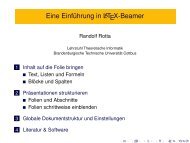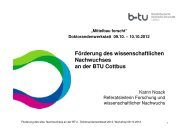Multilevel Graph Clustering with Density-Based Quality Measures
Multilevel Graph Clustering with Density-Based Quality Measures
Multilevel Graph Clustering with Density-Based Quality Measures
Create successful ePaper yourself
Turn your PDF publications into a flip-book with our unique Google optimized e-Paper software.
4.7 Comparison to Published Resultsof Reichardt and Bornholdt produces comparable good clusterings. However it ismuch slower. On nearly all graphs it is outperformed by the multi-level Kernighan-Lin refinement (ML-KL) in terms of modularity and runtime. The three slowestimplementations were spinglass, ML-KL, and leadingev. All other algorithms had arelatively constant, low runtime.4.7 Comparison to Published ResultsThis section compares the presented multi-level refinement method against otherclustering algorithms. For many of these algorithms clustering results are publishedin the papers presenting the algorithm. Because of their size clusterings are directlyprinted only for very small graphs. Commonly just the modularity value of theclusterings are published.The following discussion is based on the algorithms listed in Section 2.4 aboutfundamental clustering methods. First some general problems of this evaluationmethod are discussed. Then for each graph the modularity values found in articlesare presented. The section concludes <strong>with</strong> a small summary table comparing thebest found values to own results.Only modularity values published together <strong>with</strong> the original algorithms were consideredand for each value the source article is cited. The modularity values arecompared against two multi-level Kernighan-Lin refinement algorithms. Both usegreedy grouping <strong>with</strong> 10% reduction factor and Kernighan-Lin refinement. As mergeselector the weight density is employed by the ML-KL-density variant and the randomwalk reachability (2,3) by the ML-KL-rw variant. The first variant is the defaultconfiguration identified by the previous evaluation. In addition the other variant waschosen because for degree volume model used here it is in many cases able to findbetter clusterings.The comparison of printed modularity values embodies some general problems.Often only a few digits are printed to save space. With just three digits it is difficultto check whether the same or just similar clusterings where found. In this regardalso printing the number of clusters would be helpful. The calculation of modularitymay be done slightly different. Several variants of the modularity measure exist andsmall variations in the handling of self-edges are possible. In addition unweightededges might have been used instead of the available weighted version. Finally smalldiversities can arise in preprocessing and graph conversion by different strategies toobtain undirected, symmetric graphs. Here just the last problem is addressed byexcluding graphs when their published number of vertices and edges differs from theown version. This applies to most graphs in [64, 25, 69].4.7.1 The <strong>Graph</strong>s and <strong>Clustering</strong>sIn the following paragraphs each graph is shortly presented. Thereafter the clusteringresults are discussed. For smaller graphs also example pictures are printed.The layout was computed <strong>with</strong> the LinLog energy model [62] 5 . The best clustering5 available at http://www.informatik.tu-cottbus.de/~an/GD/79






